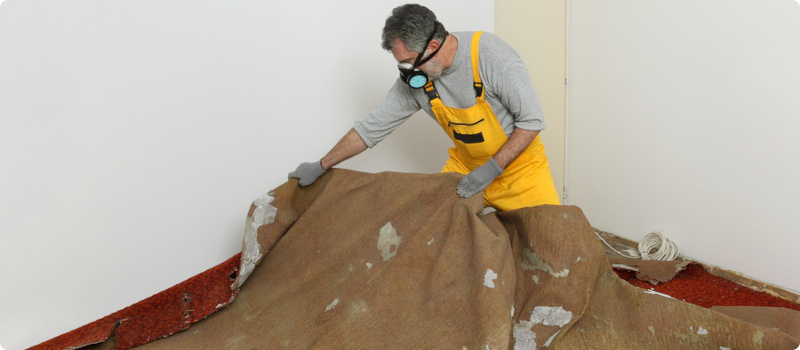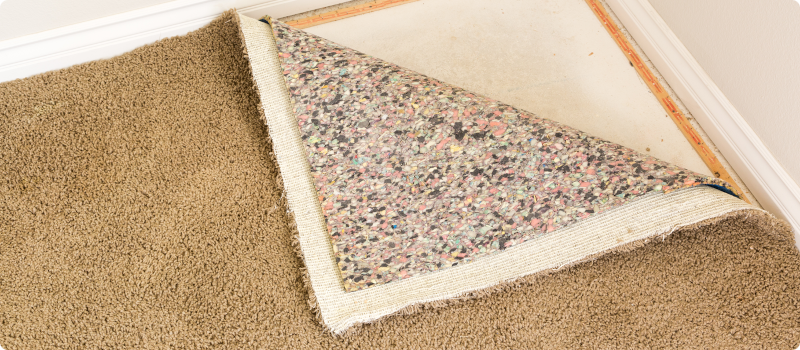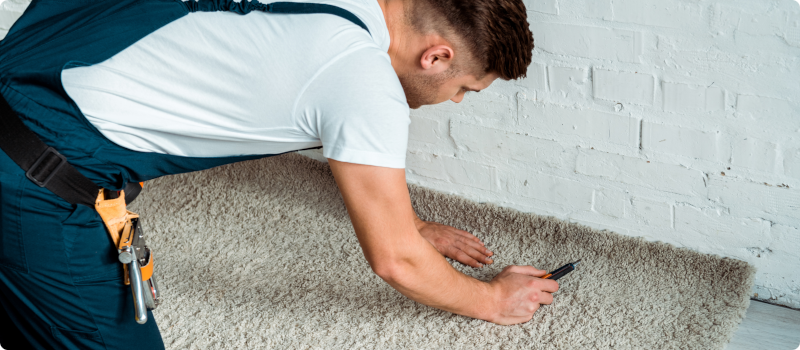How to Remove and Replace Moldy Carpet
Updated April 1, 2024 . AmFam Team
Updated April 1, 2024 . AmFam Team
Excess moisture can cause many issues in your home, mold included. And where your carpet is concerned, mold can be evasive — hiding in the fibers and sending spores into the air you breathe without you noticing. Not to worry, as there are many ways to stop mold in its tracks and prevent it from coming back.
Spotting mold in your home takes a proactive mindset. And if you’ve had any kind of liquid soaking into your carpet for extended periods of time — or if your house tends to get humid and stay humid — you might have mold. Stains and musty smells are also an indication of mold growth. It might even be growing onto the walls surrounding your carpet.
Some molds are more dangerous than others, like black molds — these varieties are almost always harmful to your health and require professional intervention. Others are relatively harmless and occur in most homes, like aspergillus, which doesn’t cause illness or irritation unless a person has a weak immune system.
Consider these telltale signs that mold may be present in your home:

Although household mold types are relatively harmless, there are a few that can be quite hazardous with prolonged exposure. Because each individual can react differently to mold, it can be difficult to rely on physical symptoms to help you understand if your home contains unhealthy mold.
Take a look at the types of dangerous mold that can sometimes be found within the home:
Mold Type | Health Effect |
|---|---|
Allergenic molds | This mold usually produces respiratory issues that can be trouble for those with asthma. Prolonged exposure can result in mild nasal and respiratory distress for those prone to asthma. |
Pathogenic molds | These are molds you need to take seriously. They can cause respiratory infections and left unchecked, can lead to concerning health issues for certain populations. Those with weak immune systems can be at an increased risk when exposed to these types of molds. |
Toxic molds | oxic molds produce dangerous and poisonous chemicals and require immediate action if they’re discovered in the home. Mycotoxin exposure, or mold toxic mold exposure, can occur by simply touching toxic mold — and by inhaling it as well. Contact a mold mitigation team to manage the safe removal of this mold upon discovery. |
If you want to try getting rid of the mold yourself before calling in a professional, you’ll need to follow a few essential steps.
Goggles, a respirator and rubber gloves are the bare minimum equipment, since mold spores can cause moderate to severe irritation to your eyes and lungs. You’ll also want to wear clothes you don’t mind being ruined, especially if the mold is particularly widespread.
Whether it’s a leak, flooding or a spill, removing the source of the moisture that’s feeding the mold growth needs to happen before you can clean up the mold itself. You can use materials like cat litter, talc-free baby powder and baking soda to soak up any liquid. Leave it on the spot overnight, the vacuum it up in the morning.
In some cases, this may be enough to stop mold in its tracks. Removing the source of moisture and drying the area out can cause many small mold colonies to die off. But if there is standing water, you may need a wet-dry vacuum to remove it and consider these tips to keep your home free of water damage.
Peel up a piece of the carpet where you suspect the mold is growing. If the mold has gone all the way through to the backing, it may be too far gone to do this yourself. If not, you can start soaking the section.

There are a few different solutions you can use to kill off mold colonies. You’ll first need to perform a base cleaning, which is best done with a rented carpet cleaner. You can also hire a professional carpet cleaning service to get that job done. After the base clean is dry, consider one of the following steps:
A common home remedy is to use white vinegar, which you can apply directly to common household without diluting it.
You can also use bleach diluted in water, but only use this method if you don’t mind your carpet being bleached out. It may also damage the fibers of your carpet, causing bald spots where you’ve cleaned.
There are industrial antifungal sprays you can use, but they can be potent and damaging to the carpet. If you think you need something that strong, you probably need to call a professional.
Vacuuming up the area after it’s dry is important, but your regular vacuum might not cut it. Experts suggest renting a HEPA vacuum to suck up any remaining spores and prevent them from dispersing into the air.
A room full of mold is not a task for one person. But even a 10-square-foot patch of mold is something you should call a professional to handle. If the mold has spread past the carpet and into the padding, insulation or floorboards, it’s also time to get some help.
Mold remediation professionals are usually educated in the different types of mold and how to get rid of them, so make sure to choose someone with a lot of experience. You’ll also have to remove the carpet entirely and replace it with new, clean carpet after the mold is destroyed.
This could be true even if there isn’t a ton of mold — if you have extensive water damage, warped floorboards beneath your carpet can cause structural trouble and need to be dealt with by removing the carpet.

Once you’ve removed the mold in your home, you’ll want to keep the humidity level low in your home, around or below 50 percent. There are many options to consider that can help maintain low humidity in your home such as installing a dehumidifier or running your bathroom fan when you use the shower.
And if you live in a swampy or tropical environment, consider leaving your windows closed to keep the moisture out. With so many ways to maintain a decent humidity in your home you’ll be able to find out what works best for your house.
Mold growth caused by lack of proper maintenance or an aging home is generally not covered by homeowners insurance. You should be aware that issues caused by improper home maintenance aren’t usually covered, either. So be sure to review your homeowners policy if you think you might be covered for a mold-related event.
Keeping mold out of your carpets is an active process that involves vigilance and regular home maintenance. Now that you have the tools and know-how to stop mold growth in its tracks, you can continue protecting your home and everything in it.
If you’re unsure whether or not a covered event that caused water damage will also cover mold removal, speak with your American Family Insurance agent.
This article is for informational purposes only and based on information that is widely available. We do not make any guarantees or promise any results based on this information.